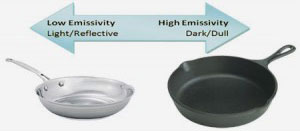What is Emissivity?
Emissivity is the ability of an object to emit or absorb energy.
 Perfect emitters have an emissivity of 1, emitting 100% of incident energy.
Perfect emitters have an emissivity of 1, emitting 100% of incident energy.
An object with an emissivity of 0.8 will absorb 80% and reflect 20% of the incident energy. Emissivity may vary with temperature and spectral response (wavelength). Handheld infrared thermometers will have difficulty taking accurate temperature measurements of shiny, metal surfaces unless they can adjust for emissivity.
Generally, the closer a material’s emissivity rating is to 1.00, the more that material tends to absorb reflected or ambient infrared energy and emit only its own infrared radiation. Most organic materials, including the by products of plants and animals, have an emissivity rating of 0.95. These are ideal surfaces for accurate temperature readings.
Substances with very low emissivity ratings, like highly polished metals, tend to be very reflective of ambient infrared energy and less effective at emitting their own electromagnetic waves. If you were to point an infrared thermometer with fixed emissivity at the side of a stainless steel pot filled with boiling water, for example, you might get a reading closer to 38°C than 100°C. That’s because the shiny metal is better at reflecting the ambient radiation of the room than it is at emitting its own infrared radiation.


